[Click on any photo to enlarge.]
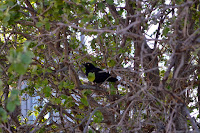 *Critters we’ve seen on our
2015 trip so far: elk, mule, mule deer
*Critters we’ve seen on our
2015 trip so far: elk, mule, mule deer
*Birds we’ve seen on our 2015
trip so far: California condor, Brewer’s
blackbird
*National Parks/Monuments visited on 2015 trip so far: 1

Our reservations were for Trailer Village Campground
located inside Grand Canyon
National Park (www.nps.gov/grca), and the day after our arrival we spotted our first
critters of this travel season…elk in the campground!
 Our last visit to the Grand Canyon
was in 2010, and though seeing the park is not as exciting as our first visits,
its beauty and grandeur still amaze us. It
was declared a national monument in 1908 by President Theodore Roosevelt and
became a national park in 1919.
Our last visit to the Grand Canyon
was in 2010, and though seeing the park is not as exciting as our first visits,
its beauty and grandeur still amaze us. It
was declared a national monument in 1908 by President Theodore Roosevelt and
became a national park in 1919.
 We drove up to the Village area, and you can tell the weather
was nice enough for short sleeves and shorts.
We had taken Abby with us and strolled along hoping to spot some California condors in
the canyon since this is the area where we’d seen them before.
We drove up to the Village area, and you can tell the weather
was nice enough for short sleeves and shorts.
We had taken Abby with us and strolled along hoping to spot some California condors in
the canyon since this is the area where we’d seen them before.
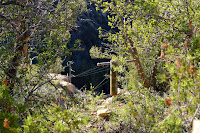 Along the way we passed the placard naming the Trans-Canyon
Telephone Line that was built in 1935 by the Civilian Conservation Corps as a
National Historic Landmark. What we had
never noticed in the past was the actual telephone lines! They extend across the canyon from the south
rim to the north rim consisting of 18 miles of copper wire and 592 metal poles
and are maintained by Mountain Bell.
These lines connect 11 emergency telephones and 4 ranger stations.
Along the way we passed the placard naming the Trans-Canyon
Telephone Line that was built in 1935 by the Civilian Conservation Corps as a
National Historic Landmark. What we had
never noticed in the past was the actual telephone lines! They extend across the canyon from the south
rim to the north rim consisting of 18 miles of copper wire and 592 metal poles
and are maintained by Mountain Bell.
These lines connect 11 emergency telephones and 4 ranger stations.
 We were
having no luck spotting the condors so I went inside Verkamp’s Visitor Center
near where we had parked, and the lady said she’d heard they’d been seen nearby
because of the warmer weather (the wind drafts assist them in flight). As I stepped out, I saw Russ frantically
waving at me to come. Turns out a pair
of condors were on the ledge below…getting busy!
We were
having no luck spotting the condors so I went inside Verkamp’s Visitor Center
near where we had parked, and the lady said she’d heard they’d been seen nearby
because of the warmer weather (the wind drafts assist them in flight). As I stepped out, I saw Russ frantically
waving at me to come. Turns out a pair
of condors were on the ledge below…getting busy!
 Condors
are one of the rarest birds in the world, weighing up to 23 lbs. with a wing
span up to 9-1/2 feet and not that long ago there were only 22 left in the
world. They generally lay one egg every two years, but the captive breeding
program begun in 1983 found a way to trick the bird into laying
Condors
are one of the rarest birds in the world, weighing up to 23 lbs. with a wing
span up to 9-1/2 feet and not that long ago there were only 22 left in the
world. They generally lay one egg every two years, but the captive breeding
program begun in 1983 found a way to trick the bird into laying
 more. As soon
as she drops an egg, a researcher will grab it before she knows it’s gone. She
thinks she hasn’t laid an egg and will produce another. Thanks to this program,
there are now 435 condors worldwide, nearly all wearing numbered tags and
transmitters.
more. As soon
as she drops an egg, a researcher will grab it before she knows it’s gone. She
thinks she hasn’t laid an egg and will produce another. Thanks to this program,
there are now 435 condors worldwide, nearly all wearing numbered tags and
transmitters.
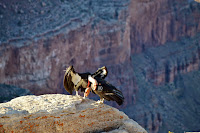 More than half of them are
flying free in the wild with about 75 of them in AZ and UT. They can soar and
glide up to 50 mph and can fly 5,000 - 6,000 feet above the canyon rim. Condors
do not build nests but instead lay an egg on the floor of a cave, ledge, or
tree. They mate for life, and we were
More than half of them are
flying free in the wild with about 75 of them in AZ and UT. They can soar and
glide up to 50 mph and can fly 5,000 - 6,000 feet above the canyon rim. Condors
do not build nests but instead lay an egg on the floor of a cave, ledge, or
tree. They mate for life, and we were
 watching female #80 who is 15 years old and her mate, #87, who is 17 years old
(they can live up to 60 years old in the wild).
Afterwards, they stood on the ledge for a bit, and then one by one took
off. There’s nothing like watching them
soar above the canyon.
watching female #80 who is 15 years old and her mate, #87, who is 17 years old
(they can live up to 60 years old in the wild).
Afterwards, they stood on the ledge for a bit, and then one by one took
off. There’s nothing like watching them
soar above the canyon.
 The next day we drove to the Visitor Center
at Mather Point and watched its 20 min. film “Grand Canyon: A Journey of Wonder”.
Just outside the center sandblasted into the pavement is a
representation of the Tribal Medallion.
It symbolizes those tribal people who call the canyon home and has their tribal names oriented around the edge of the medallion in the general direction
of each of their current homelands.
The next day we drove to the Visitor Center
at Mather Point and watched its 20 min. film “Grand Canyon: A Journey of Wonder”.
Just outside the center sandblasted into the pavement is a
representation of the Tribal Medallion.
It symbolizes those tribal people who call the canyon home and has their tribal names oriented around the edge of the medallion in the general direction
of each of their current homelands.
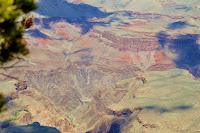 We walked along stopping at various locations for views of
the canyon and even a glimpse of the Colorado River. In the bottom third of the photo at right,
about in the center, that little green triangle is the mighty Colorado.
It’s located
We walked along stopping at various locations for views of
the canyon and even a glimpse of the Colorado River. In the bottom third of the photo at right,
about in the center, that little green triangle is the mighty Colorado.
It’s located
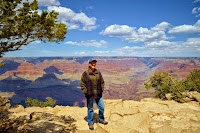 a mile below the rim which is how far it has cut into the
rock layers over millions of years to carve out the canyon. As you can tell by our clothing, the
temperatures had
a mile below the rim which is how far it has cut into the
rock layers over millions of years to carve out the canyon. As you can tell by our clothing, the
temperatures had
 dropped and the wind had picked up so shorts were definitely
out of the question! Our final stop was
at the Yavapai Observation Station which is dedicated to the geology of the
canyon and its creation, also noting the differences between the
dropped and the wind had picked up so shorts were definitely
out of the question! Our final stop was
at the Yavapai Observation Station which is dedicated to the geology of the
canyon and its creation, also noting the differences between the
 north and south
rims. In most of the pictures taken of
the canyon on this trip, you can tell there was a general haze which does not
help the photos due justice to the beauty seen by the naked eye.
north and south
rims. In most of the pictures taken of
the canyon on this trip, you can tell there was a general haze which does not
help the photos due justice to the beauty seen by the naked eye.
 We caught the shuttle back to the car and decided to make
a stop at the Pioneer
Cemetery located within
the park. The entryway was erected in
1928, and people buried there include Grand Canyon pioneers, war veterans, tribal members, and
employees of the
We caught the shuttle back to the car and decided to make
a stop at the Pioneer
Cemetery located within
the park. The entryway was erected in
1928, and people buried there include Grand Canyon pioneers, war veterans, tribal members, and
employees of the
 National Park Service. One of the tombstones is a memorial to
the 128 people who lost their lives on June 30, 1956, during the collision of
two commercial airliners over the Grand Canyon.
At the time it was the worst disaster in aviation
National Park Service. One of the tombstones is a memorial to
the 128 people who lost their lives on June 30, 1956, during the collision of
two commercial airliners over the Grand Canyon.
At the time it was the worst disaster in aviation
 history and brought about
sweeping changes in air traffic control. During our last visit to the park, we had
taken a ranger led walk through the cemetery at night which was fascinating,
and we find it a very peaceful, moving, and respectful place.
history and brought about
sweeping changes in air traffic control. During our last visit to the park, we had
taken a ranger led walk through the cemetery at night which was fascinating,
and we find it a very peaceful, moving, and respectful place.
 A free shuttle
bus operates four routes on the park’s South Rim, and on the next day we took
the shuttle to the transfer exchange area for the red route that would take us
the 7 miles out to Hermits Rest. No cars are allowed along the red route from
Mar. - Nov. so it is only accessible by shuttle.
A free shuttle
bus operates four routes on the park’s South Rim, and on the next day we took
the shuttle to the transfer exchange area for the red route that would take us
the 7 miles out to Hermits Rest. No cars are allowed along the red route from
Mar. - Nov. so it is only accessible by shuttle.
 Hermit’s Rest was constructed in 1914 built
into the side of the hill and made of stone and wood. Though the road ends here, the Grand Canyon continues on for another 180 miles through
undeveloped areas and Indian reservations.
Hermit’s Rest was constructed in 1914 built
into the side of the hill and made of stone and wood. Though the road ends here, the Grand Canyon continues on for another 180 miles through
undeveloped areas and Indian reservations.
 There are
several stops along the red route where you can get off to view the Canyon
and/or see other historical sites. One
stop included a view of a portion of Orphan Mine that was used for 13 years for
uranium mining, producing ore at the height of the Cold War with operations
ending in 1969. After all these years,
they are still working to clean up the contamination from this site.
There are
several stops along the red route where you can get off to view the Canyon
and/or see other historical sites. One
stop included a view of a portion of Orphan Mine that was used for 13 years for
uranium mining, producing ore at the height of the Cold War with operations
ending in 1969. After all these years,
they are still working to clean up the contamination from this site.
 The views
are spectacular including an even better view of the river, and while many lookout points have guard rails, most do not and
there are always those adven-turous folks who like to push the envelope sitting
on the edge like these folks below left. Most of the time we prefer
to play it safe…that first step could be your last!
The views
are spectacular including an even better view of the river, and while many lookout points have guard rails, most do not and
there are always those adven-turous folks who like to push the envelope sitting
on the edge like these folks below left. Most of the time we prefer
to play it safe…that first step could be your last!
 Another
stop is at the Powell Monument that honors adventurer John Wesley Powell,
leader of the first documented expedition through the Grand
Canyon in 1869 lasting 3 months on the Green and Colorado Rivers. Having lost
an
Another
stop is at the Powell Monument that honors adventurer John Wesley Powell,
leader of the first documented expedition through the Grand
Canyon in 1869 lasting 3 months on the Green and Colorado Rivers. Having lost
an
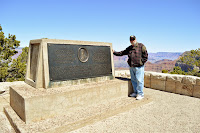 arm in the Civil War did not hinder his sense of adventure, and he led a
second expedition through the Canyon in 1872.
arm in the Civil War did not hinder his sense of adventure, and he led a
second expedition through the Canyon in 1872.
 Once we
returned to the bus exchange point, we decided to walk over to the historic Kolb
Studio. Established in 1904 by the Kolb
Brothers as a photographic studio, it was operated by one of the brothers until
his death in 1976. It is now a gift
shop, information center, and museum run by the Grand Canyon Association and is
currently undergoing some renovations.
Once we
returned to the bus exchange point, we decided to walk over to the historic Kolb
Studio. Established in 1904 by the Kolb
Brothers as a photographic studio, it was operated by one of the brothers until
his death in 1976. It is now a gift
shop, information center, and museum run by the Grand Canyon Association and is
currently undergoing some renovations.
 A little
further down is the Lookout Studio that was built in 1914 of natural limestone
from nearby quarries. Now it’s basically
a gift shop but has natural stone stairs out back leading down to an area
overlooking the canyon. We’ve taken them
in the past, but this time decided to simply view from the upper porch
inside. Renovations are being done to
this building as well.
A little
further down is the Lookout Studio that was built in 1914 of natural limestone
from nearby quarries. Now it’s basically
a gift shop but has natural stone stairs out back leading down to an area
overlooking the canyon. We’ve taken them
in the past, but this time decided to simply view from the upper porch
inside. Renovations are being done to
this building as well.
 While
waiting for the blue route shuttle to return to our car, we watched as the Grand
Canyon Railway (www.thetrain.com) made
its departure. This passenger train
operates between Williams, AZ and the Canyon’s south rim and has since 1901
with a brief stoppage during the 70s and early 80s when a businessman finally
bought it and brought it back to life.
Vintage diesel engines and passenger coaches take folks on a spectacular
ride.
While
waiting for the blue route shuttle to return to our car, we watched as the Grand
Canyon Railway (www.thetrain.com) made
its departure. This passenger train
operates between Williams, AZ and the Canyon’s south rim and has since 1901
with a brief stoppage during the 70s and early 80s when a businessman finally
bought it and brought it back to life.
Vintage diesel engines and passenger coaches take folks on a spectacular
ride.
Also on a
nearby track sits Locomotive No. 29 which was restored in 2004 at a cost of
more than $1 million. It’s an SC-3 class
locomotive having been built in 1906 and weighs 185 tons. It currently is in semi-retirement in front
of the Grand Canyon Depot.
 The
weather had continued to get colder and a winter storm was on the horizon the
next day, but late that afternoon, we drove up to the Village area again to
check out a couple more places. As you
can see, the fog/mist was already moving into the canyon. First stop was the historic Hopi House built
in 1905 which is currently used as a gift shop/museum for mainly Native
American crafts. Designed to resemble a
traditional Hopi pueblo, Russ just barely made it through the doorway without
having to bend over!
The
weather had continued to get colder and a winter storm was on the horizon the
next day, but late that afternoon, we drove up to the Village area again to
check out a couple more places. As you
can see, the fog/mist was already moving into the canyon. First stop was the historic Hopi House built
in 1905 which is currently used as a gift shop/museum for mainly Native
American crafts. Designed to resemble a
traditional Hopi pueblo, Russ just barely made it through the doorway without
having to bend over!


Across
from it is the historic El Tovar Hotel, also built in 1905, and designed to be
a cross between a Swiss chalet and a Norwegian villa. It has 78 rooms and
suites and from what we’ve heard, no two rooms are alike. Located only about 20 ft. from the canyon
rim, it was built from native stone and Oregon pine and has a very cozy lobby,
a perfect place to relax. The exterior
of the hotel is also undergoing renovations.
 The next
morning we awoke to a little bit of snow and ice though nothing was sticking to
the road. It had dipped to 22 degrees
the night before, and even though we had left the water at a steady stream, we found a
leak underneath the RV evidenced initially by an icicle. We couldn’t see its origin and since we’d be
using the water tank the rest of our trip, we decided we’d have to wait until
we got to Yellowstone to investigate further.
The next
morning we awoke to a little bit of snow and ice though nothing was sticking to
the road. It had dipped to 22 degrees
the night before, and even though we had left the water at a steady stream, we found a
leak underneath the RV evidenced initially by an icicle. We couldn’t see its origin and since we’d be
using the water tank the rest of our trip, we decided we’d have to wait until
we got to Yellowstone to investigate further.
 It was
time to leave and our path heading towards the East entrance would take us past
another area of the park known as Desert View.
The focal point of this area is The Watchtower. Built in 1932, this 70 foot stone tower is
the highest point on the South Rim and has
It was
time to leave and our path heading towards the East entrance would take us past
another area of the park known as Desert View.
The focal point of this area is The Watchtower. Built in 1932, this 70 foot stone tower is
the highest point on the South Rim and has
 Hopi murals on the interior walls.
Originally it was an observation station and rest stop for Grand
Canyon visitors. Today it has a gift shop on the first floor and
climbing the narrow stairs still offers spectacular views of the canyon and
surrounding area including an even better view of the Colorado
River.
Hopi murals on the interior walls.
Originally it was an observation station and rest stop for Grand
Canyon visitors. Today it has a gift shop on the first floor and
climbing the narrow stairs still offers spectacular views of the canyon and
surrounding area including an even better view of the Colorado
River.

3 comments:
Beautiful pics of the Condors! Sallie
Those condors give new meaning to "fly united". Joe & Nancy
Thanks, Susan and Russ ! Mary Jane and I have never been to the "Big Ditch". Thanks to you---WE NOW HAVE ! Fred
Post a Comment